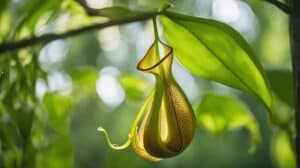Yucca (Yucca elephantipes) is a popular decorative plant that adds a touch of elegance to any desert landscape. Known for its tall, slender stem and striking green leaves, this plant is a favorite among gardeners and landscapers alike. However, propagating Yucca can be a challenge, especially for those new to gardening. In this article, we will simplify the process of propagating Yucca, making it accessible to even the most inexperienced gardeners.

Propagation is the process of creating new plants from existing ones. There are several methods of propagating Yucca, including stem cuttings, offsets, and seed germination. Each method has its own advantages and disadvantages, and the choice of which method to use will depend on the gardener’s preferences and resources. This article will focus on stem cuttings, which is one of the easiest and most reliable methods of Yucca propagation. With a little bit of patience and care, anyone can successfully propagate Yucca and enjoy the beauty of this elegant plant in their own garden.
Understanding Yucca Elephantipes
Species Profile
Yucca elephantipes, also known as spineless yucca, is a species of flowering plant in the family Asparagaceae. It is native to Central America and is widely cultivated as an ornamental plant due to its attractive foliage and low maintenance requirements. The plant can grow up to 30 feet tall and has a thick, woody stem that can reach up to 1 foot in diameter. Its leaves are long, sword-shaped, and grow in a rosette pattern at the top of the stem.
The plant produces white, bell-shaped flowers in the summer, which are followed by fleshy, edible fruit. While yucca elephantipes is generally considered to be a slow-growing plant, it can live for several decades under the right conditions.
Growth Characteristics
Yucca elephantipes is a hardy plant that is well-suited to desert environments. It requires well-draining soil and plenty of sunlight, but can tolerate a range of temperatures and soil types. The plant is drought-tolerant and can survive extended periods without water, making it an ideal choice for xeriscaping.
Propagation of yucca elephantipes is typically done through stem cuttings or by dividing the plant at the root. The plant is relatively easy to propagate and can be grown from cuttings taken in the spring or fall. It is important to allow the cuttings to dry out for a few days before planting them in well-draining soil to prevent rot.
Overall, yucca elephantipes is a versatile and attractive plant that is well-suited to a variety of landscaping applications. With a little care and attention, it can thrive in a range of environments and provide years of enjoyment for gardeners and plant enthusiasts alike.
Propagation Basics

Yucca elephantipes, commonly known as Yucca, is a popular ornamental plant that can be propagated easily. The following are the basic steps for propagating Yucca:
Preparation Steps
Before propagating Yucca, it is important to ensure that the parent plant is healthy and disease-free. The following are the preparation steps:
- Choose a healthy parent plant: Select a parent plant that is healthy and free from diseases or pests. The parent plant should also be mature and have a strong root system.
- Prepare the cutting: Use a sharp, sterilized knife or pruning shears to cut a stem from the parent plant. The stem should be at least 6 inches long and have several leaves attached to it.
- Allow the cutting to dry: Place the cutting in a dry, shaded area and allow it to dry for a few days until the cut end has calloused over.
Propagation Methods
There are two primary methods for propagating Yucca: stem cuttings and offsets.
- Stem cuttings: Take a stem cutting from the parent plant and allow it to dry. Dip the cut end in rooting hormone and plant it in a well-draining potting mix. Water the cutting sparingly and keep it in a warm, bright location until roots form.
- Offsets: Yucca plants produce offsets or “pups” that can be separated from the parent plant and planted individually. Wait until the offset has grown to at least 6 inches tall before separating it from the parent plant. Plant the offset in a well-draining potting mix and water it sparingly.
By following these simple steps, anyone can propagate Yucca and enjoy the beauty of this elegant desert plant in their own home or garden.
Caring for Your Propagated Yucca

After successfully propagating Yucca elephantipes, it’s important to provide the proper care to ensure its growth and health. This section covers the optimal growing conditions, common pests and diseases, and maintenance and pruning techniques for your propagated Yucca.
Optimal Growing Conditions
Yucca elephantipes thrives in a warm, dry environment with plenty of sunlight. It prefers well-draining soil and should be watered deeply but infrequently, allowing the soil to dry out between watering. Overwatering can lead to root rot and other fungal diseases.
Yucca elephantipes can tolerate a range of temperatures, but it prefers temperatures between 60-80°F (15-27°C). It can also tolerate low humidity levels, making it an ideal plant for arid climates.
Common Pests and Diseases
While Yucca elephantipes is generally a hardy plant, it can still fall victim to pests and diseases. Common pests include spider mites, mealybugs, and scale insects. These pests can be controlled with insecticidal soap or neem oil.
Fungal diseases, such as root rot and leaf spot, can also affect Yucca elephantipes. To prevent these diseases, ensure proper drainage and avoid overwatering. If your plant does become infected, prune affected areas and treat with a fungicide.
Maintenance and Pruning
Yucca elephantipes requires minimal maintenance, but pruning can help promote growth and maintain its shape. Remove any dead or damaged leaves as they appear, and prune back any leggy or overgrown stems. Yucca elephantipes can also be propagated through stem cuttings taken during pruning.
In conclusion, by providing optimal growing conditions, monitoring for pests and diseases, and performing regular maintenance and pruning, your propagated Yucca elephantipes can thrive and bring desert elegance to your home or garden.
Frequently Asked Questions

How can I propagate Yucca elephantipes from stem cuttings?
Yucca elephantipes can be propagated from stem cuttings by taking a cutting that is about 4-6 inches long and removing the bottom few leaves. Allow the cutting to dry for a few days before planting it in well-draining soil. Keep the soil moist but not waterlogged and the cutting should root in a few weeks.
Is it possible to root Yucca elephantipes cuttings in water?
No, it is not recommended to root Yucca elephantipes cuttings in water. The plant prefers well-draining soil and rooting in water can cause the cutting to rot.
What’s the best way to plant Yucca cuttings directly in the soil?
To plant Yucca cuttings directly in the soil, prepare a hole that is slightly larger than the cutting and fill it with well-draining soil. Place the cutting in the hole and gently pack the soil around it. Water the cutting thoroughly and keep the soil moist but not waterlogged.
Can you grow Yucca from side shoots, and if so, how?
Yes, Yucca elephantipes can be propagated from side shoots. To do this, carefully remove the side shoot from the parent plant and plant it in well-draining soil. Keep the soil moist but not waterlogged and the cutting should root in a few weeks.
What are the steps to planting Yucca cuttings in pots?
To plant Yucca cuttings in pots, choose a pot that is slightly larger than the cutting and fill it with well-draining soil. Plant the cutting in the soil and gently pack the soil around it. Water the cutting thoroughly and keep the soil moist but not waterlogged.
How long does it take for Yucca cuttings to root?
Yucca cuttings typically root in a few weeks, but it can take up to a few months for the cutting to establish a strong root system. Be patient and keep the soil moist but not waterlogged during this time.













